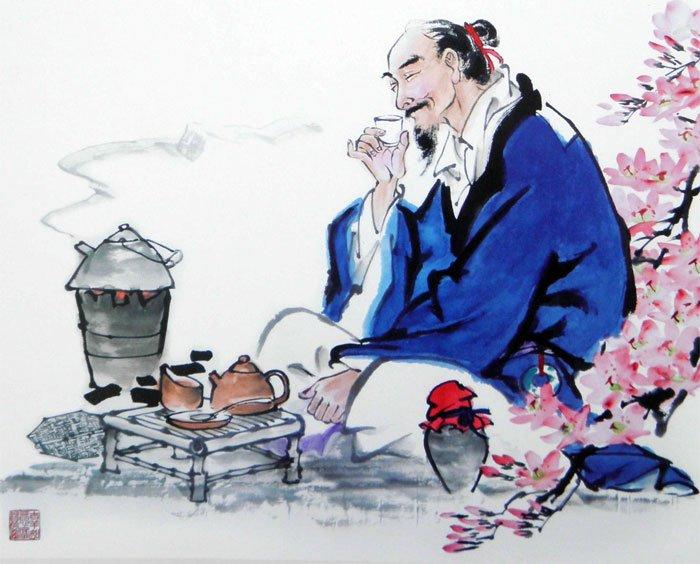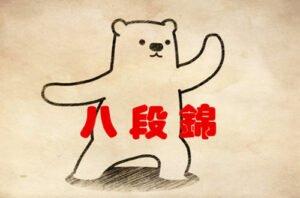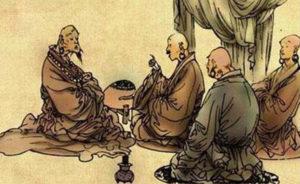Text written in the early 20th century by Zhen Gou (1857-1920)
The method of brewing tea has been lost to transmission for a long time. The men who fancy themselves refined, no doubt, are for the most part fond of tea, but are content to boil fresh leaves with water and drink them as they are. There are no people nowadays who understand tea brewing as described in the “Canon of Tea” and “Tea Records” (by Lu Yu (733-804) and Cai Xiang (1012-1067), respectively). The “Tea Cups” of Tu Binding True (the nickname of the Ming litterateur Tu Lun (1542-1605)) discusses tea in great detail, but also brewed rather than boiled.
In my youth I was drawn to all kinds of arts, and by nature I was particularly fond of tea. Each time I began to study the Canon of Tea, I read it over and over again, and with the passage of time I seemed to come to an understanding. Just at that time I accompanied my late father to Weiyang (the old name of Yangzhou in Jiangsu Province), and since excellent tea is collected there, I bought tea accessories and began to brew tea according to the pattern. After that, I realized that the ancients brewed tea to acquire the real taste of tea. And when descendants brew tea, isn’t it the same as eating the peels from Yuan family pears? (Han Yuan Zhong grew especially large and delicious and juicy pears. They were called Yuan pears.)
At home at rest, having plenty of leisure time, I compiled these chapters as a gift to those equally enthusiastic.
1. Selection of utensils
When choosing utensils, the most important thing is the boiling kettle. There is nothing more difficult than to find an excellent kettle. The ancients used stone kettles, but nowadays you can’t find them, and it is not convenient to use them. After all, in the kettle is especially valued thinness of the walls, which accelerates boiling. A stone kettle cannot be thin. Nowadays copper kettles are used, but they have a character of hard to bear odor and astringency, and in fact in the kettle is especially valued purity, which quite reveals the taste. Copper kettle can not be clean. As for ceramic ones, they are not fireproof, and only clay teapots can be recommended. The current Guangdong white clay teapots with a small neck and round body are best. In fact, the neck should not be made wide, otherwise the flavor of the tea will dissipate. And northern clay teapots have exactly this disadvantage. Therefore, the best assistant in tea drinking will be a white clay teapot. When dealing with a new teapot, it is necessary to cook rice broth in it a couple of times to remove the earthy spirit. As time passes, the teapot gets better and better.
Next in importance is the wind stove (table stove on a tripod for boiling water). The triangular-shaped charcoal wind stoves from Jingshi are excellent. The stove should of course not be too large. It is best that one charcoal refill is just enough for one kettle.
Next in importance are the tea cups. It is best to have thick walls so that the tea cools down more slowly. The modern imitations of Lan-yao and Qing-tian-yao made in Jiangxi are excellent.
This is followed by a tea scoop, which is used to measure the water. Ceramic ones are not durable, but coconut palm is the way to go. Neither bamboo nor copper is suitable.
Next, a water bottle (a vessel with a narrow neck and wide body) sized for two or three sheng of water is placed next to the stove and kept ready. It is best if it has a lid.
Next comes the opahala. They are made of Chinese livostone or feathers, because they are good at chasing air.
2. Tea selection
Among teas, Bilochun from Suzhou takes priority. If it is difficult to get, then Hangzhou Tianchi (‘Heavenly Pond’) will do. Lunjing is somewhat worse. Among the teas Shaotsu (‘Thick Tips’) of Mount Jie (one of the famous ancient teas, produced in Jiangsu Province, Yixing County, Lotsze Shan Mountain) some are excellent, but I have not seen them. Then there is Emerald Liuan (one of the famous ancient teas, produced in Anhui Province, in the town of Liuan. Minsky Chen Ting calls it “the first in the Celestial Empire”. It is still being produced today). As for Wuyin, Jun-shan, Mendin teas, I know them only by their names. The ancients always ground and pressed the tea like the current Puer, but in this way the authenticity of the tea is lost. Our contemporaries only dry on fire, without grinding, in which they surpass the ancients. Of course, this requires a proper harvesting method and drying mode, otherwise the flavor of the tea will not be revealed.
If you are going to keep it for a long time, you can dry it again, but do not leave it longer than one year. Excellent tea has a flavor of its own, but without boiling it cannot be brought out. Nowadays, tea is often served with flowers and fruits, and the flavor of the tea is completely lost. Besides, when brewed properly, tea is not bitter, but on the contrary sweet in a way that the worldly people cannot know. If there is no excellent tea, even with average tea, but with good water, the flavor can also be revealed.
The tea must be kept in absolutely airtight vessels, best of all in tin, firmly soldered. The neck is tightly closed with paper, the vessel is placed in a wooden box, and the box is set in a high place.
3. Water selection
…
4. Cooking method
Su Dong-po (Su Shi, 1037-1101) has the lines:
Crab Eyes Already Passed
Fish Eyes Born
It’s About to Rumble
The Wind Rumbles in the Pines
These words accurately capture the finest secret of tea brewing. In general, the main thing in brewing tea is entirely reduced to “waiting for the boiling water”. One pours water into the kettle, lays charcoal in the stove and relies on the power of the furs. At this time the waving of the opahal must not be stopped for a second. They wait for small bubbles to appear on the surface, which are crab eyes. A little later, large bubbles appear, these are fish eyes. At this time a quiet sound becomes audible, it means that the wind is rustling in the pines. When the crab eyes have just appeared, one or two scoops of water are scooped out of the kettle, and when the time of wind noise in the pines comes, they pour it back in, thus stopping the boiling. Then they drop the tea leaves, 2 qian (one qian equals 3.125 g. or according to another system, 3.7301 g. ) of leaves into a kettle holding half a sheng (one sheng equals 1.04 liters) of water. After a little while, the water boils again, and when it begins to bubble, the tea is ready.
But this point is the hardest to keep track of. If over-ripened, the tea will become old, “old” meaning that the flavor is gone and the water is darkened and cloudy. If not aged, it will remain unripe, “unripe” means that the aroma has not yet emerged, the color of the water is still weak, the solution is unsaturated. In both cases, the rules of preparation are not followed. And if they are not observed, then all labor goes to waste, nothing can be corrected.
Although tea brewing is an insignificant activity, its secret is difficult to convey in words. If you take it lightly, you will not learn anything. Only when you have a long, worry-free day ahead, your heart is at peace and your hands are not busy, and the thought of tea suddenly comes to you, then put on the stove, light the fire and start waving the wand smoothly, listening relaxedly to the flute of the tea, and the tea will surely be excellent.
When making tea, always first wash the leaves in warm water to remove dirt and dust. The tea should be measured accurately, using a scoop of suitable size, so that you can take as much tea as you need at a time, depending on the amount of water.
When brewing tea, fire with soot and soot should be avoided at all costs. Lu Yu calls it “tea devil.” The best charcoal is made from soo wood (perhaps stuartia false camellia, or cyathea fine thorn), from which the bark has been previously stripped. Having loaded the stove, you should wave the opahal from the beginning to the end without a single stop. If you stop, the result will not be perfect.
5. Tea Party
The ancients, when they drank tea, rinsed the cups to warm them and only then poured the tea. There is a deeper meaning in this. After all, hot cups do not let the tea cool down quickly. The tea does not cool down, and its flavor does not change. The whole secret of good tea is in keeping the fire and warming the cups, which tea cups should be small, so that you can drink it immediately and pour it again without letting the contents cool down.
Lu Yu argued that boiling water can be old and immature. Many people do not believe this, not realizing that even in cooking, it is necessary to follow the fire, and tea, as a formalized entity, does not need to follow the fire. Immature water going into the mouth leaves a sense of insubstantiality and seems empty. Old water, going down the throat, leaves a feeling of heaviness and is not swallowed. Both are equally unfit for drinking. Only if you bring it to a third boil three times does it taste great. Once in the mouth, such water feels weighty, but as it goes down the throat, it becomes light. If you taste it with the tip of a bent tongue, it seems as if it is empty and there is nothing there. When following the fire produces such a result, it is the height of perfection. When it is achieved, the tea tastes supremely sweet and fragrant, and you want to swallow it in one gulp. Brewed tea is bitter and tart, and our contemporaries also praise its excellent taste. This is simply out of line.
Boiled tea brings untold joy. If the day is auspicious and good, there are two or three close friends, whose hearts are carefree and hands are idle, and the conversation does not dry up and does not bore, then you can resort to the ancient method to maintain a beautiful state. If, however, entangled with worldly cares, the people are ranting, interrupting each other, and the purity is gone, it is better to wait for another moment.
Source: Renzi


